I usually choose to use synthetic division when factorising polynomials, but I know some teachers are unhappy when their students do this. So for completeness, here is my PDF for Polynomial Long Division.
Category Archives: Factorising
Simultaneous Equation (or is it?)
Solve simultaneously
We could attempt to solve this simultaneously, but I think the algebra would be tricky.
The three equations are related to the roots of a cubic polynomial.
If the general equation of the polynomial is ![]() , then we know
, then we know
The sum of the roots
The product of the roots
and
So from our three equations we have
(1) ![]()
(2) ![]()
(3) ![]()
Let ![]() , then
, then ![]() , and
, and ![]()
Our cubic is ![]() and we can try to solve it.
and we can try to solve it.
The roots will be factors of ![]() , so
, so ![]()
Try ![]()
![]()
Hence ![]() is a root.
is a root.
Use synthetic division to find the quadratic factor
The quadratic factor is ![]() , which factorises to
, which factorises to ![]()
Hence the solutions are ![]() , and
, and ![]()
We could assume the solutions are natural numbers, then we can look at factors of 30.
| Factors of Thirty | ||
Hence the solutions are ![]() and
and ![]()
But with this approach we might not be able to find the solutions.
Factorising Non-Monic Quadratics
The general equation of a quadratic is ![]()
Let’s explore different methods of factorising a non-monic quadratic (the ![]() term is not
term is not ![]() )
)
Factorise ![]()
We need to find two numbers that add to ![]() and multiply to
and multiply to ![]() (i.e. add to
(i.e. add to ![]() and multiply to
and multiply to ![]()
The two numbers are ![]() and
and ![]()
Method 1 – Splitting the middle term
This is the method I teach the most often
![]()
Split the middle term (the ![]() term) into the two numbers
term) into the two numbers
![]()
The order doesn’t matter.
Find a common factor for the first term terms, and then for the last two terms.
![]()
There is a common factor of ![]() , factor it out.
, factor it out.
![]()
Method two – Fraction
![]()
Put ![]() into both factors and divide by
into both factors and divide by ![]()
![]()
Factorise
![]()
![]()
![]()
Method 3 – Monic to non-monic
![]()
Multiply both sides of the equation by ![]()
![]()
![]()
![]()
Let ![]()
![]()
Factorise
![]()
Replace the ![]() with
with ![]()
![]()
![]()
![]()
![]()
Method 4 – Cross Method
![]()
Place the two numbers in the cross
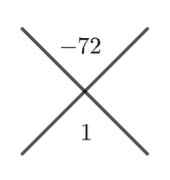
Place the two numbers that add to ![]() and multiply to
and multiply to ![]() in the other parts of the cross.
in the other parts of the cross.
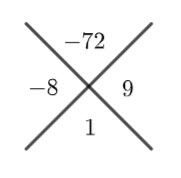
Divide these two numbers by ![]() (i.e
(i.e ![]() )
)
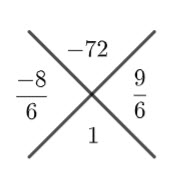
Simplify
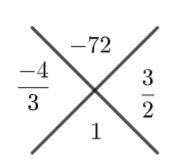
Hence,
![]()
Which is
![]()
Method 5 – By Inspection
This is my least favourite method – although students get better with practice
![]()
The factors of ![]() are
are ![]() and
and ![]() and the factors of
and the factors of ![]() are
are ![]()
We know one number is positive and one number negative.
Which give us all of these possibilities
| Possible factorisations | ||
| No | ||
| No | ||
| No | ||
| No | ||
| No | ||
| Almost, switch the signs | ||
| Yes |
![]()
With a bit of practice you don’t need to check all of the possibilties, but I find students struggle with this method.
Method 6 – Grid
![]()
Create a grid like the one below
Find the two numbers that multiply to ![]() and add to
and add to ![]() and place them in the other grid spots (see below)
and place them in the other grid spots (see below)
Find the HCF (highest common factor) of each row and put in the first column.
Row ![]() HCF=
HCF=![]() , Row
, Row ![]() HCF=
HCF=![]()
For the columns, calculate what is required to multiple the HCF to get the table entry.
For example, what do you need to multiple ![]() and
and ![]() by to get
by to get ![]() and
and ![]() ? In this case it is
? In this case it is ![]() . It’s always going to be the same thing, so just use one value to calculate it,
. It’s always going to be the same thing, so just use one value to calculate it,
The factors are column ![]() and row
and row ![]()
![]()
The two methods I use the most are splitting the middle term, and the cross method, but I can see value in the grid method.
Filed under Algebra, Factorising, Factorising, Polynomials, Quadratic, Quadratics
Infinite Product Expansion of cos (x)
Remember
(1) ![]()
We know that ![]() for odd integer multiples of
for odd integer multiples of ![]() , i.e.
, i.e. ![]() , which is
, which is ![]() for
for ![]()
Hence,
![]()
for ![]()
We can factorise our ![]() expansion
expansion
![]()
We know ![]()
![]()
![]()
![]()
Solving Cubic Functions
I have been thinking about cubics a bit lately because some of my students are solving and then sketching cubics. Plus I am reading An Imaginary Tale by Paul Nahin, which talks about solving cubics and complex numbers.
Cubics must have at least one real root. If one of the roots is a rational number, then we can use the Factor and Remainder Theorem.
For example,
Solve ![]()
| We know the root(s) must be a factor of I always start with Try Then we can do polynomial long division. Now we know that And we can factorise the quadratic (or using the quadratic equation formula) |
But what if it is not factorisable?
For example,
Solve ![]()
How many roots does this equation have?
We could find the derivative and find out how many stationary points the function has.
![]()
This is a quadratic function. Find the discriminant to determine the number of roots.
![]()
As ![]() , there are two stationary points, which means we could have 1, 2 (one root is repeated) or three roots, depending on if the function crosses the
, there are two stationary points, which means we could have 1, 2 (one root is repeated) or three roots, depending on if the function crosses the ![]() axis between stationary points. So not much use.
axis between stationary points. So not much use.
We could try the discriminant of a cubic.
![]()
![]()
The discriminant is negative so there is one real root.
From my reading, we need to turn the cubic into a depressed cubic (cubics of the form ![]() ).
).
We can do this by using a change of variable.
| Let Substitute |
We can then use Cardano’s formula
![]()
We can see from the sketch below that there is only one solution and it is about ![]() .
.
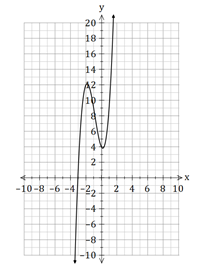
Filed under Cubics, Factorising, Polynomials, Solving










